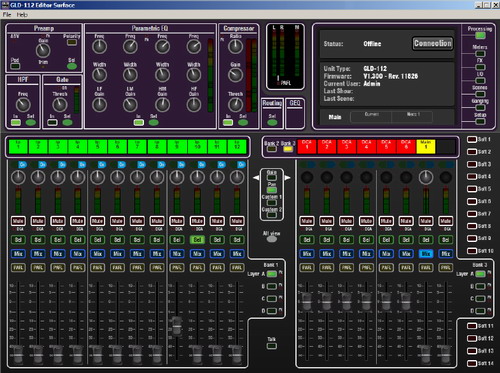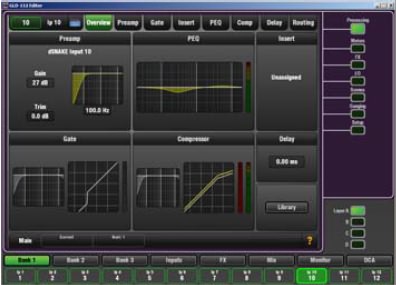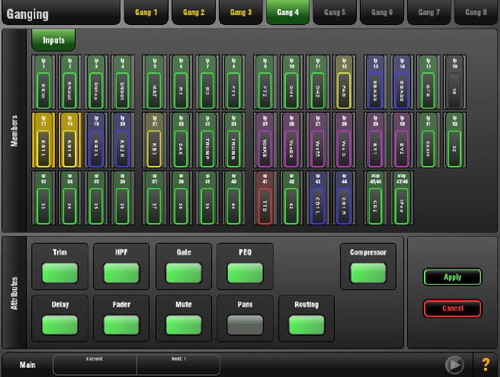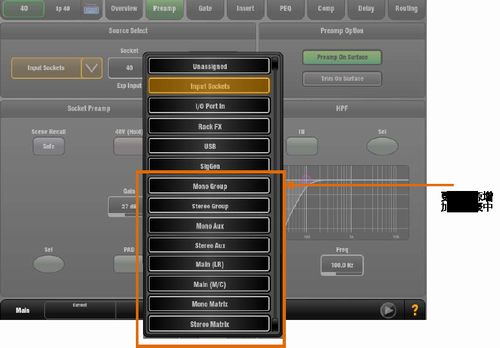The Allen & Heath GLDGLD firmware version has been upgraded again, with new features:
Support for GLD Editor software The new software application runs on a PC, MAC desktop, notebook or touch tablet and provides full configuration and control of the GLD Series consoles. Editor is available for GLD-80 and GLD-112 mixers. The Show created on one of the consoles can be run on another one. Simply reassign the channel strips to fit a different number of faders. It can also be used on GLD Remote and OneMix's GLD interface as well as on multiple iPads.

The Editor software configures the settings offline, and these settings can be connected directly or via a USB flash drive to the GLD console. For example: pre-set your show on a warehouse or tour bus.
The online Editor software can control the GLD console in real time by connecting the rear panel network interface. Users can establish a connection using a wired (LAN) or wireless (Wi-Fi) network. An additional wireless router (access point) is required for wireless operation.

The Editor Surface window simulates the physical control interface of GLD. Its status interface allows you to make offline editing settings or connect to a GLD console online.
The Editor Screen window simulates the touch screen interface of the GLD console, making it easy for users to control the processing, routing, scenes and settings.
 Added gain trimming in the group (Ganging)
Added gain trimming in the group (Ganging)
Channel gain trimming control is now included in the parameters that can be implemented in Gangd. For example, one hot input level can be adjusted simultaneously for two mono channels for a stereo keyboard, only one of which is assigned to the fader channel strip. Gain control cannot be grouped because the preamp is not part of the channel but can be assigned to any channel or mix.
Mixing output can be used as a channel source Any grouping, auxiliary, main output, or matrix output can now be used as the source for the input channel or as an external input to the mix. Because it usually does not use these outputs as a sound source, this feature works well for some special applications that require additional flexibility. For example: routing the main output L to a mono matrix, the main output R is used for separate control of the L&R mixing process.

Bug fix: The release of this version also fixes some other minor issues.
A single-phase VFD, also known as a variable frequency drive, is a specialized electronic device used for precise control and regulation of single-phase motors. Unlike three-phase motors that are commonly used in industrial applications, single-phase motors are predominantly found in residential and small-scale applications.
The primary function of a single-phase VFD is to control the frequency and voltage supplied to the single-phase motor, thereby enabling accurate regulation of motor speed. By adjusting the frequency and voltage output, the VFD allows for smooth and precise control over the motor's rotational speed. This feature is particularly useful in applications where speed control is required, such as in residential HVAC systems, small-scale machinery, and household appliances.
Energy efficiency is a significant advantage offered by single-phase VFDs. By adjusting the motor speed to match the load requirements, the VFD reduces energy wastage and improves overall energy efficiency. When the motor operates at a lower speed during periods of low demand, energy consumption is significantly reduced, resulting in energy savings and lower operating costs.
Motor protection is another important aspect addressed by single-phase VFDs. They incorporate various protective features, including overload protection, short circuit detection, and thermal protection, which help safeguard the motor against damage due to excessive current, voltage fluctuations, or overheating. This ensures reliable motor operation, prolongs the motor's lifespan, and reduces the risk of unexpected failures.
Harmonic filtering is also a critical consideration in single-phase VFD applications. When single-phase VFDs operate, they can introduce harmonics into the power supply, which may cause issues such as voltage distortions and interference with other electrical equipment. To mitigate these problems, single-phase VFDs often incorporate harmonic filtering techniques to suppress harmonics and ensure a clean and stable power supply, maintaining power quality and preventing damage to connected equipment.
Control algorithms play a significant role in single-phase VFD operation. These algorithms allow for precise control and adjustment of motor speed, ensuring smooth acceleration, deceleration, and accurate speed regulation. Advanced control algorithms enable efficient motor operation and enhance overall system performance.
In summary, single-phase VFDs provide precise control and regulation of single-phase motors in residential and small-scale applications. With their energy efficiency, motor protection features, harmonic filtering capabilities, and advanced control algorithms, single-phase VFDs enhance motor performance, reduce energy consumption, and ensure reliable operation in various residential and small-scale applications.
Single Phase Vfd,220V Frequency Inverter,Ac Frequency Inverter,High Frequency Inverte
WuXi Spread Electrical Co.,LTD , https://www.vfdspread.com